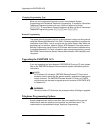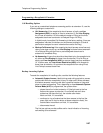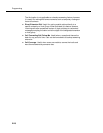
Using Telephone Programming
2-33
■ Use Extension Name Display to assign a user’s name to the
extension. See Chapter 5 for the character codes. (Like Automatic
Line Selection, this procedure must be done immediately after you
enter programming mode and dial the extension number. If you want
to change both Automatic Line Selection and Extension Name
Display, first change Automatic Line Selection, then press
c, redial the extension number, then use Extension
Name Display.)
■ Use Line Ringing to change the ringing for an individual line or
pool.
For
standard phones
, you must now also program all other extension
features.
For
non-display system phones
, you may also want to program all
extension features at this point.
To erase the current programming from a button, press the button, then
press
!.
5. To change the settings for another extension, press
c, then dial
the new extension number.
6. To exit programming mode, you can press
f 0 0, or lift the handset
off-hook, then place it back in the cradle.
Changing Programming Type
When you are in programming mode, you can move between System
Programming and Centralized Telephone Programming. To change to System
Programming when you are in Centralized Telephone Programming, press
c then s. To move back to Centralized Telephone
Programming when you are in System Programming, press
c.
Using Extension Programming
Users can program features or store numbers on buttons from their own phones
using Extension Programming. Keep in mind the following exceptions:
■ Automatic Line Selection, Line Ringing, and Call Screening (F25)
always must be programmed using Centralized Telephone Programming.
■ If a user has a standard phone, Personal Speed Dial Numbers for the
extension can be programmed only by using Centralized Telephone
Programming.
■ If a user has a standard phone or a non-display system phone, Extension
Name Display for the extension can be programmed only by using
Centralized Telephone Programming.


















